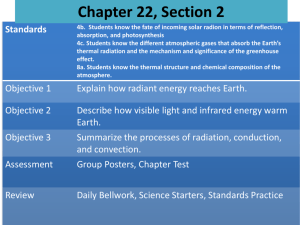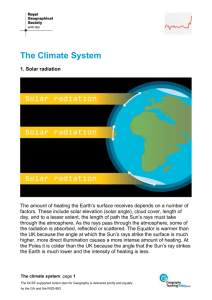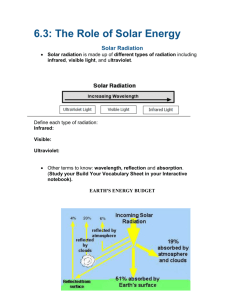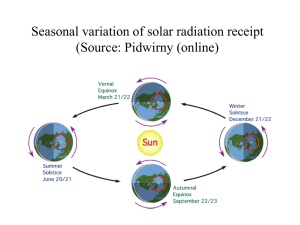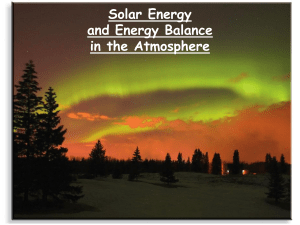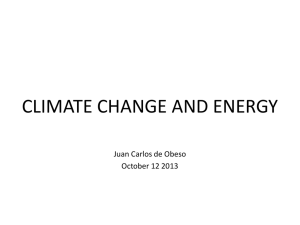5 - Cal State LA - Instructional Web Server
advertisement
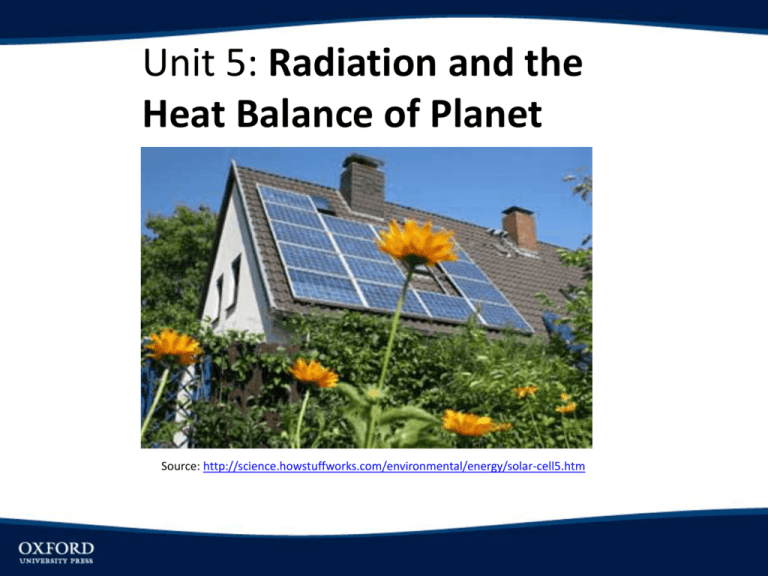
Unit 5: Radiation and the Heat Balance of Planet Earth Source: http://science.howstuffworks.com/environmental/energy/solar-cell5.htm OBJECTIVES • Understand the processes by which heat flows within the Earth system • Follow the cascade of Solar energy to the Earth’s surface and the resulting energy exchanges between surface and atmosphere • Link the greenhouse effect to the Earth’s habitability • Understand latitudinal differences in net radiation • Explore global energetics The Electromagnetic Spectrum Figure 2.6 Solar and Terrestrial Radiation Emission by the Sun and Earth on a per unit area basis. Both emit radiation over many wave-lengths, but there is little overlap in their emission curves. Note that the curves are not drawn at the same scale. The terrestrial axis is exaggerated by a factor of 1,000,000 relative to the solar curve. Heat Conduction between the Earth’s surface and the sub-surface Daily and Seasonal Patterns Heat is conducted from higher toward lower temperatures. On a daily basis heat is stored in the soil column during the day and lost at night. Similarly, seasonal average temperature gradients lead to heat storage and loss in the warm and cold seasons. The daily temperature cycle does not extend very far into the soil, but the day/night temperature range is large compared to the seasonal cycle. Latent and Sensible Heat Transfer • Conduction • Convection • radiation Sensible and latent forms of convective heat transfer. At left conduction and radiation from the warm surface move heat into the atmosphere. After that vertical and horizontal motions produce a corresponding transfer of sensible heat into cooler parts of the atmosphere. On the right water vapor is carried upward by mixing and to the left by winds. This results in both a vertical and horizontal latent heat transfer. The Radiation Balance Solar radiation flow in the atmosphere Reflectivity, albedo Source: http://www.cgd.ucar.edu/ccr/aboutus/staff/kiehl/EarthsGlobalEnergyBudget.pdf Global distribution of heat flow • Tropics receives more energy than the poles • Heat must be transported from tropics to polar regions (a) Annual radiation gains and losses through the top of the atmosphere as a function of latitude. The vertical axis gives heat gain or loss per degree of latitude, which allows for a better comparison between latitudes. (b) Horizontal energy transport by ocean and atmosphere. Positive values are for northward heat transfer, whereas negative values denote transport to the south. The atmosphere curve includes both latent and sensible transfer. Heat Transfer • Conduction – Molecule-to-molecule transfer • Convection – Energy transferred by movement • Advection – Horizontally dominant movement • Radiation – Energy traveling through air or space Heat Transfer Figure 3.7 Greenhouse with and without ventilation Greenhouses are warm because the heated air is confined within (a). A little ventilation drastically lowers temperature despite little effect on the transmission of radiation. Greenhouse effect of the atmosphere Cartoon depiction of the greenhouse effect. Because of clouds and greenhouse gases, emission to space is effectively from a cold location high in the atmosphere (a). Adding greenhouse gases raises the emission altitude, resulting in less emission to space (b). Eventually warming throughout the column leads to a new equilibrium when emission again balances absorbed solar radiation (c).





